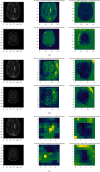Single and Combined Neuroimaging Techniques for Alzheimer's Disease Detection
- PMID: 34335726
- PMCID: PMC8292054
- DOI: 10.1155/2021/9523039
Single and Combined Neuroimaging Techniques for Alzheimer's Disease Detection
Abstract
Alzheimer's disease (AD) consists of the gradual process of decreasing volume and quality of neuron connection in the brain, which consists of gradual synaptic integrity and loss of cognitive functions. In recent years, there has been significant attention in AD classification and early detection with machine learning algorithms. There are different neuroimaging techniques for capturing data and using it for the classification task. Input data as images will help machine learning models to detect different biomarkers for AD classification. This marker has a more critical role for AD detection than other diseases because beta-amyloid can extract complex structures with some metal ions. Most researchers have focused on using 3D and 4D convolutional neural networks for AD classification due to reasonable amounts of data. Also, combination neuroimaging techniques like functional magnetic resonance imaging and positron emission tomography for AD detection have recently gathered much attention. However, gathering a combination of data can be expensive, complex, and tedious. For time consumption reasons, most patients prefer to throw one of the neuroimaging techniques. So, in this review article, we have surveyed different research studies with various neuroimaging techniques and ML methods to see the effect of using combined data as input. The result has shown that the use of the combination method would increase the accuracy of AD detection. Also, according to the sensitivity metrics from different machine learning methods, MRI and fMRI showed promising results.
Copyright © 2021 Morteza Amini et al.
Conflict of interest statement
The authors declare no conflicts of interest.
Figures














References
-
- Schmidt M. E., Janssens L., Moechars D., et al. Clinical evaluation of [18F] JNJ-64326067, a novel candidate PET tracer for the detection of tau pathology in Alzheimer’s disease. European Journal of Nuclear Medicine and Molecular Imaging. 2020;47(13):3176–3185. doi: 10.1007/s00259-020-04880-1. - DOI - PMC - PubMed
Publication types
MeSH terms
LinkOut - more resources
Full Text Sources
Medical

